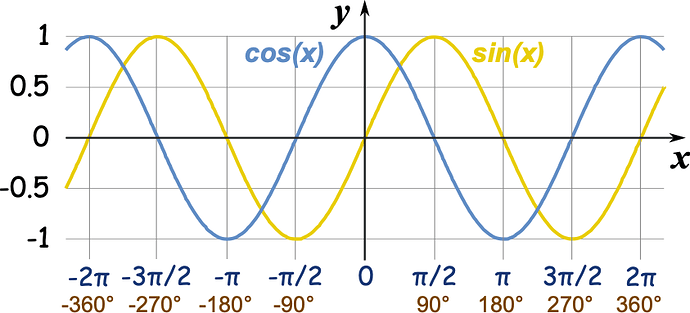There are few things in Maths less “abstract” than sinus and cosinus.
Look at a “standard” circle (with a radius of 1 to make things easier):
That’s what sinus and cosinus are. Abstract? Absolutely not.
You can also see that sin(x) and cos(x) vary between -1 and 1
If the radius is twice as large, then sinus and cos are twice as large (you multiply with the radius)
sin(alpha) in a circle of radius 1 = 1 * sin(alpha)
sin(alpha) in a larger/smaller circle of radius r = r * sin(alpha)
As you can see sin and cos are related by 90 degree.
You can easily see that if you plot sin and cos against the angle alpha or the arc length (remember that 360 degree = the circumference of the circle = 2 * radius * pi and as the radius is 1 it is ≈ 6.283185307…) as shown in this graph:
sinus and cosinus look the same, just moved by 90 degree = π / 2 ≈ 1.570796327
Now remember for graphs that if you add something to the FUNCTION you move the graph UP (eg the graph for x^2 + 1 is the x^2 graph moved up by 1), and if you subtract something you move it DOWN.
To move it LEFT and RIGHT you add/subtract something in the function argument, (x+1)^2 would move the parable graph to the LEFT, and (x-1)^2 would move the graph to the RIGHT.
If you make the FUNCTION negative then you mirror on the horizontal axis (eg x^2 vs -x^2), and if you make the variable negative you mirror on the vertical axis, eg (-x)^2 … which incidentally looks the same as x^2, so better compare (x-1)^2 with (-x-1)^2
Now on a circle whether you go 90 degree one way or 270 degree the other way, you still end up at the same spot.
So we could write
normal sinus curve: sin(alpha) =
cosinus curve moved to the RIGHT by 90: cos(alpha - 90) =
cosinus curve moved to the LEFT by 270: cos(alpha + 270) =
cosinus curve mirrored on vertical axis and moved to the RIGHT by 90: cos(90 - alpha) = cos( -alpha + 90) =
cosinus curve mirrored on vertical axis and moved to the LEFT by 270: cos(-270 - alpha) = cos( -alpha - 270) =
cosinus curve mirrored on horizontal axis and moved to the LEFT by 90: -cos(alpha + 90) = cos( -alpha + 90) =
cosinus curve mirrored on horizontal axis and moved to the RIGHT by 270: -cos(alpha - 270) = cos( -alpha - 270) =
or … etc etc
Boogles the mind but it all comes down to that in a circle you can go round and round and round - and the values just keep repeating … so the graph goes up and down and up and down and …  until you go
until you go 
![]()
![]() ). Sorry.
). Sorry.![]()



